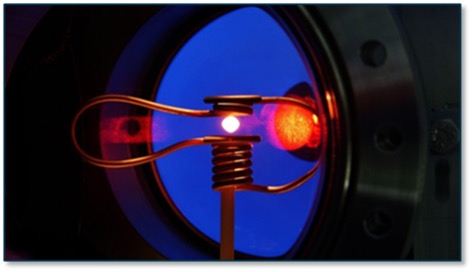
The German Space Agency at DLR and the European Space Agency have recently opened a joint Announcement of Opportunity (AO) to solicit research proposals for containerless electromagnetic processing experiments in parabolic flight (TEMPUS). TEMPUS is used for the study of solidification mechanisms (e.g., crystal nucleation and growth, multiphase growth, and glass formation) and the measurement of thermo-physical properties (e.g., specific heat capacity, surface tension and viscosity) of metallic and semi-conductor materials. Extending scientific knowledge in these areas is of pinnacle importance in further advancing the predictive capabilities of numerical modelling approaches for casting and solidification processes, which in turn are key to the manufacturing of almost all (metallic) industrial and consumer goods on Earth.
In TEMPUS, a sample is levitated by an electromagnetic field that is created by an alternating high-frequency current passing through a coil. The induced eddy currents in the sample lead to heating and positioning, and by that enable containerless processing of for instance highly reactive liquid metals. In microgravity – such as during the 0g phase in parabolic flight – no lifting force but only a residual positioning force is needed. This means that the coil current can be strongly reduced after melting, so that stirring of the molten droplet is minimised. Therefore, investigations can be performed under well-defined and reduced convection conditions. The 0g phase during a parabola of the used Novespace Airbus A310 Zero G provides about 20 seconds of weightlessness which thereby sets the time window for the investigations and measurements during a single TEMPUS experiment cycle. A flight day consists of 31 parabolas, while the full parabolic flight campaign is to include three flight days.
Experiment proposals from European science teams can be submitted to the OSIP platform (accessible through DLR/ESA TEMPUS 2023 Research Announcement). More information on this AO is also available from there. The scope of the call includes – but is not limited to – the study of novel alloy compositions and/or solidification phenomena. TEMPUS experiments can also be a stepping-stone towards scientific investigations using the Electro-Magnetic Levitator on-board the International Space Station (EML-ISS). The submission deadline for this TEMPUS AO is April 12, 2023; 24:00 CET. The actual DLR parabolic flight campaign will take place from Bordeaux, France, in September 2023.
![[Translate to English:]](/fileadmin/_processed_/f/0/csm_logodgm-4_b2722eeace.png)
![[Translate to English:]](/fileadmin/user_upload/logodgm-4.png)